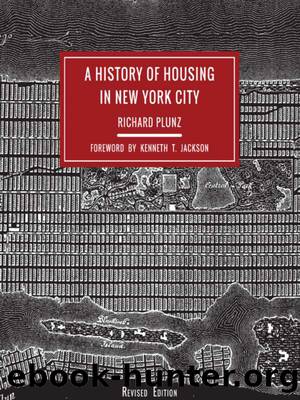A History of Housing in New York City (Columbia History of Urban Life) by Richard Plunz

Author:Richard Plunz [Plunz, Richard]
Language: eng
Format: azw3
Tags: ARC010000, Architecture/Urban &, Land Use Planning, HIS036100, History/United States/New York
Publisher: Columbia University Press
Published: 2016-10-18T00:00:00+00:00
Figure 8.8. Serge Chermayeff. âPark-Type Apartmentsâ study, published in 1943 to demonstrate the possibilities for the efficient incorporation of a wide range of apartment sizes and types within conventional slab block massing, exhibited at the Architectural League coincidental with announcements of the design for Stuyvesant Town.
Figure 8.9. Marcel Breuer. Alternative site plan for Stuyvesant Town, which reduced the coverage by 20 percent and the density by 20 percent; published in the interest of âcomparative studyâ in 1944.
The low cost of the suburban single-family house was subsidized heavily by the federal government, indirectly through the building of the highway and service infrastructure, and directly through mortgage insurance and tax laws. In his study for the Brookings Institution, Henry Aaron documented the degree to which the single-family house was subsidized by government policy after World War II. By the end of the war, all of the enabling mechanisms for the mortgage guarantees had been long established. Most dated from the New Deal: the Federal Home Loan Bank system in 1932, the FHA loan guaranty programs in 1934, and the Veteransâ Home Loan Guaranty Program in 1944. More important than the mortgage guarantees were the income tax laws, which even today continue to give substantial advantage to home owners. According to Aaron:
If the homeowner were taxed like other investors, he would have to report as gross income the rent he could have obtained on his house. He would be allowed deductions for maintenance, depreciation, mortgage interest, and property taxes as expenses incurred in earning income. The difference, or net rent, would be his taxable income. In fact, rather than paying a tax on his imputed net rent, he is allowed to deduct mortgage interest and property taxes from his gross income.39
Aaron calculated that for a typical year (1966), the government subsidy provided to the poor by public housing programs was $500 million, while the subsidy provided primarily to middle-class home owners through the income tax law was almost $7 billion.40 There were a myriad of other subsidies that supported the new lifestyle. Many were focused on the road and services infrastructure needed to sustain the massive infusion of private automobiles.41
At the close of World War II, optimism regarding the postwar boom together with priorities given to housing the returning veterans almost completely destroyed the established government housing programs for the poor. Legislative efforts to renew them, begun in 1944, were unsuccessful. In that year, the Senate created the Special Committee on Postwar Economic Planning and Policy, which drafted the Wagner-Ellender-Taft (WET) Bill. The bill called for the creation of a permanent National Housing Agency that would operate through the existing Federal Home Bank, Federal Housing, and Federal Public Housing administrations. According to the provisions of the bill, the Federal Home Bank and Federal Housing Administration would increase aid to private enterprise. The Federal Public Housing Administration would enlarge the public housing program by placing greater emphasis on local needs, especially through new programs for slum clearance, with increased government sponsorship of housing research.
Download
This site does not store any files on its server. We only index and link to content provided by other sites. Please contact the content providers to delete copyright contents if any and email us, we'll remove relevant links or contents immediately.
The Secret History by Donna Tartt(16690)
The Social Justice Warrior Handbook by Lisa De Pasquale(11501)
Thirteen Reasons Why by Jay Asher(7815)
This Is How You Lose Her by Junot Diaz(5810)
Weapons of Math Destruction by Cathy O'Neil(5062)
Zero to One by Peter Thiel(4845)
The Myth of the Strong Leader by Archie Brown(4800)
Promise Me, Dad by Joe Biden(4463)
Beartown by Fredrik Backman(4452)
How Democracies Die by Steven Levitsky & Daniel Ziblatt(4435)
Stone's Rules by Roger Stone(4429)
The Fire Next Time by James Baldwin(4358)
100 Deadly Skills by Clint Emerson(4097)
A Higher Loyalty: Truth, Lies, and Leadership by James Comey(4047)
Rise and Kill First by Ronen Bergman(4029)
The David Icke Guide to the Global Conspiracy (and how to end it) by David Icke(3901)
The Farm by Tom Rob Smith(3886)
Secrecy World by Jake Bernstein(3795)
The Doomsday Machine by Daniel Ellsberg(3744)
